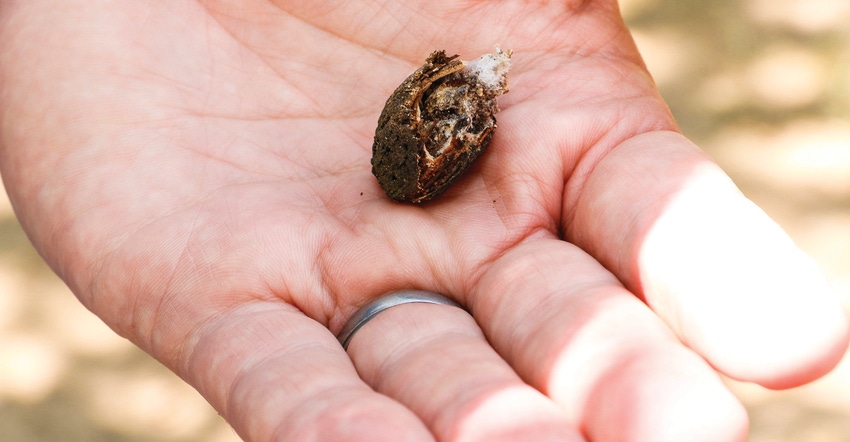
[Part of a continuing series on the navel orangeworm.]
Within the next month California almond farmers will consider their "May spray" as a hedge against Navel orangeworm damage in this year's crop. This can be part of a two-to-three spray regime growers may employ throughout the year to control a troublesome pest in tree nuts.
Even so, available insecticides to safeguard crops against the NOW moth are said to be few, and growers are advised to be cautious with how they employ these tools for resistance management.
Chris Whipple, a pest control advisor with GAR Bennett near Fresno, cautions growers to be careful what active ingredients (AI) they use as this will dictate the use of a different AI later in the season.
For instance, pyrethroids are not recommended because of their broad-spectrum danger to bees and beneficial insects. The University of California's Integrated Pest Management website at https://tinyurl.com/tcxefk4 has detailed information on various chemistries and their use in tree nuts.
Waiting to use pyrethroids as an early hull split spray can be just as bad because it can wipe out the beneficial insects useful in controlling mite populations. Mite populations tend to increase significantly ahead of harvest as irrigation is cut back and trees become stressed.
"The hull split timing is right when you're starting to cut back water to the trees," Whipple said. "This puts the trees under stress, and when that happens the trees are prone to getting mites. If you do a pyrethroid spray at that time you're going to take out your beneficials and it's very likely that you're going to have a mite flare up, at which point you'll end up needing another insecticide application."
Different products
The University of California lists seven different products on its integrated pest management website for spring sprays, and 11 different products for hull split timing. UC recommendations suggest avoiding pyrethroids at all cost in the spring, and generally avoiding them in almond orchards altogether.
University specialists recommend spring sprays only in orchards with a history of high NOW damage and high trap captures in the central and southern San Joaquin Valley. Trap counts can be tricky for those using mating disruption technology, so consider that and consult your pest control advisor and an Extension entomologist if you have questions at all.
For growers in the northern San Joaquin Valley and Sacramento Valley, spring sprays for peach twig borer can have secondary benefits to suppress NOW populations. Dedicated NOW sprays in these regions are most effective at hull split, according to the UCIPM website.
Hull split sprays are critical because of the exposure that activity provides feeding NOW moths to almond and pistachio kernels. Not only is feeding damage a concern to the marketability of those nuts, food safety issues can come with it.
Whipple says growers will generally apply three insecticide treatments throughout the season for NOW control: one in the spring and two during hull split. Targeted products that do not impact beneficial insects useful in mite control are encouraged.
University recommendations
Good insecticide timing and the proper use of registered insecticides are one of four tenets of good Navel orangeworm control in tree nuts, according to Extension advisers. Included in this list are an effective use of winter sanitation practices, mating disruption technology and early harvest timing where practical.
According to Whipple, harvest timing is largely dependent upon equipment availability and not everyone can harvest at the same time because of equipment and crew availability. Harvest timing in typically impacted orchards can be more important than those with generally lower NOW populations.
The proliferation of tree nuts has created greater opportunities for the NOW moth to reproduce and feed on maturing nuts. Warmer winters have only aided in their lifecycle, adding to the necessity for cultural practices that can reduce over-wintering moths. Of this four-pronged approach, none are capable of complete control absent the other practices, though researchers say winter sanitation is by far the most critical piece to this puzzle as it can reduce overwintering moth populations and give growers a head start with insect control as the season progresses.
About the Author(s)
You May Also Like






